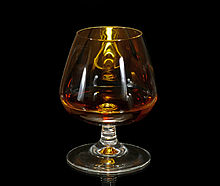
Back Brandewyn Afrikaans Weinbrand ALS براندي Arabic براندى ARZ Brandi AST Бренди Bashkir Weinbrand BAR Брэндзі Byelorussian Брэндзі BE-X-OLD Бренди Bulgarian
 Cognac brandy in a typical snifter | |
| Type | Distilled beverage |
|---|---|
| Country of origin | France |
| Introduced | 15th century |
| Alcohol by volume | 35–60% |
| Proof (US) | 70°–120° |
| Ingredients | wine |
| Variants | pomace brandy, fruit brandy |
| Related products | Armagnac, Cognac |
Brandy is a liquor produced by distilling wine. Brandy generally contains 35–60% alcohol by volume (70–120 US proof) and is typically consumed as an after-dinner digestif. Some brandies are aged in wooden casks. Others are coloured with caramel colouring to imitate the effect of aging, and some are produced using a combination of aging and colouring. Varieties of wine brandy can be found across the winemaking world. Among the most renowned are Cognac and Armagnac from south-western France.[1][2]
In a broader sense, the term brandy also denotes liquors obtained from the distillation of pomace (yielding pomace brandy), or mash or wine of any other fruit (fruit brandy).[3][1] These products are also called eau de vie (literally "water of life" in French).
- ^ a b Brandy at the Encyclopædia Britannica
- ^ "Brandy". BBC. Retrieved 22 July 2014.
- ^ Kirk-Othmer Food and Feed Technology. John Wiley & Sons. 14 December 2007. p. 151. ISBN 9780470174487.